The Mexican Fireleg Tarantula (Brachypelma Boehmei) is a New World species found mainly on the pacific coast of Mexico and Central America.
Its unique pattern and beautiful colors make it a popular choice for spider collectors. If the beautiful legs of the Mexican Fireleg have grabbed your attention and you’re considering adding it to your collection, here’s everything that you need to know about this beautiful species.
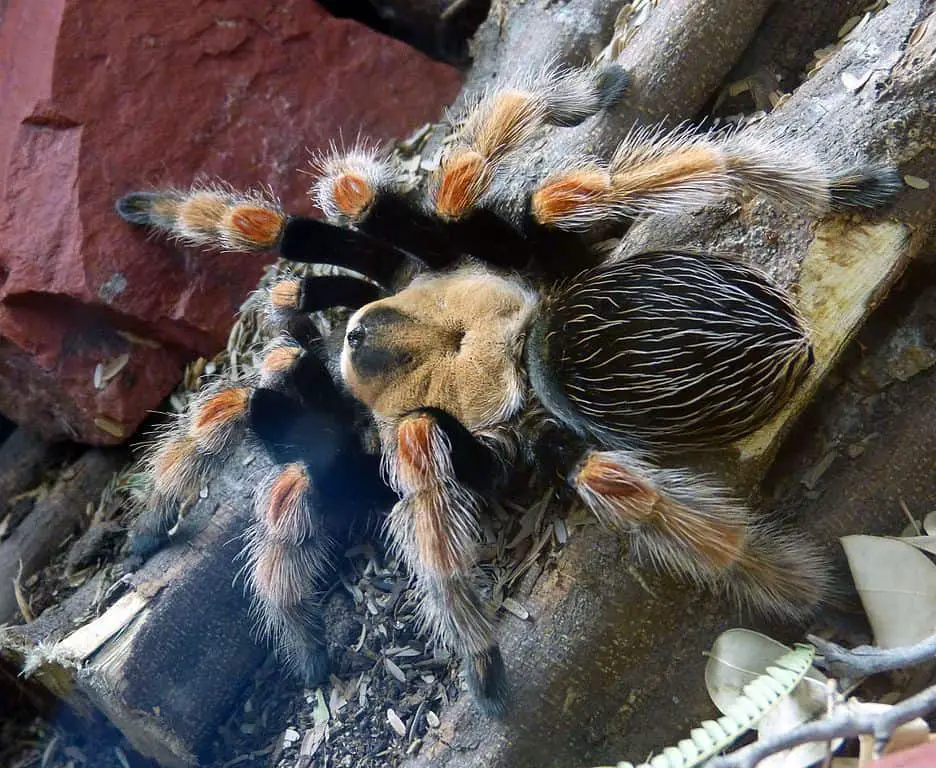
Mexican Fireleg Tarantula Care Sheet
| Species Name | Brachypelma boehmei |
| Family Name | Theraphosidae |
| Common Name | Mexican Fireleg Tarantula |
| Category | New World |
| Type | Terrestrial Burrower |
| Native Location | Mexico & Belize |
| Body Length | 2.5 to 2.75 inches (6.5 – 7cm) |
| Leg Span | 6.5 inches (17cm) |
| Growth Speed | Slow |
| Urticating Hairs | Yes, type III |
| Social | Solitary |
| Diet | Insects: crickets, roaches, mealworms. Also birds in the wild. |
| Temperature | 70 to 75 degrees Fahrenheit |
| Humidity | 70 to 80% |
| Life Expectancy | Females, up to 25 years. Males, 8 years |
| Recommended Experience Level | Intermediate |
| Minimum tank size | 18 inches long * 12 inches wide * 12 inches high |
Mexican Fireleg Tarantula overview
The Mexican Fireleg Tarantula is a terrestrial, opportunistic burrower. She can move very quickly, and the urticating hair can be exceptionally irritating, but she’s not prone to bite. This spider would prefer to run and hide than bite, and her venom is considered mild.
She’s a terrestrial spider and an opportunistic burrower, so she’s most comfortable with plenty of places to hide. They’re very slow growers, growing only around one inch per year during their spiderling phase; this most likely has to do with their incredibly long lifespan, giving them ample time to grow into their full size.
As some of the most long-living spiders, this species might be a good choice for you if you have a tendency to get attached to your tarantulas. Skittish and nervous, the Mexican Fireleg Tarantula makes up for her behavior with the striking colors she displays.
Appearance and variants
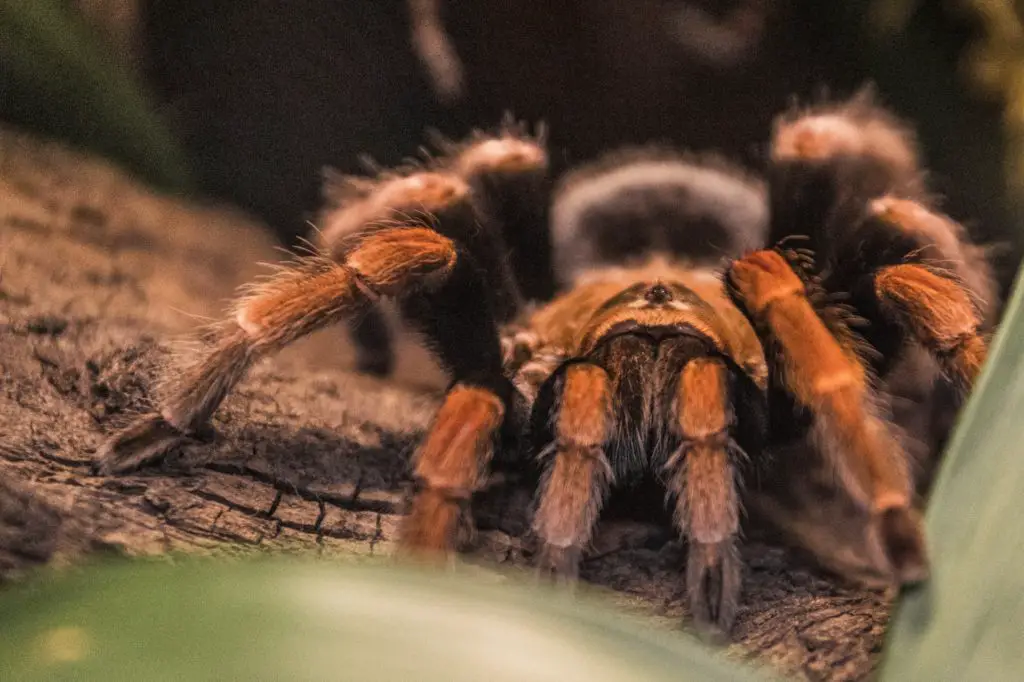
The Mexican Fireleg is very similar to other members of the Brachyphelma. Bright orange colors over a black background seem to be the rule with this genus.
However, the Mexican Fireleg Tarantula has a unique orange pattern that looks like it’s wearing bright orange slit sleeves over the legs. Male and female specimens are very similar and hard to tell apart. The females are slightly larger, but in terms of pattern and color, they’re almost always identical. The only way to accurately identify their sex is to examine the inside of a molt.
These spiders are about average in size for tarantulas with a leg span of 6.5 inches and a body length of around 2.5 inches.
Price
As is common with tarantulas, the cost of purchasing the spider itself depends on the developmental stage and whether you’re purchasing a female or male specimen.
Spiderlings typically go for around $40, juveniles cost about $80, and adult females can be found for as much as $450, though they can be found cheaper.
Adult males, because of their significantly shorter lifespan, go down to around $120.
Behavior and Temperament
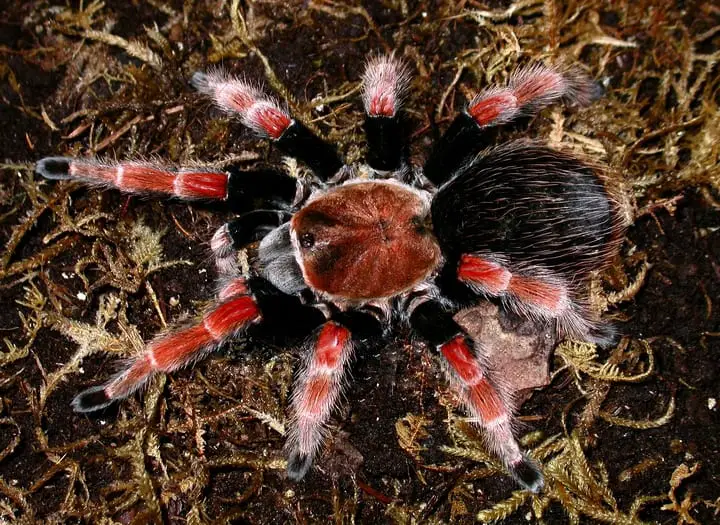
The Mexican Fireleg Tarantula is more skittish and nervous than other tarantulas in its genus. Generally speaking, members of the Brachyphelmas genus are known for being docile and easy to handle, the Mexican Fireleg, however, is quick to kick hairs, and her hairs are particularly irritating.
Handling these tarantulas is not advisable, and more so, you shouldn’t stick your hand into their tanks for any reason without wearing gloves to avoid having your skin irritated for days. It’s also important that you make sure that the urticating hairs do not end up in your eyes as this can cause serious damage.
This species is not prone to biting humans, and when they do bite, their venom is luckily not very dangerous unless you’re allergic. Typically they first try to flee from situations where they feel threatened, if that does not work they release their setae, biting is only really used as a defense of last resort.
Caring for a Mexican Fireleg Tarantula
Temperature and Humidity
The Mexican Fireleg Tarantula lives in savanna and shrubland biomes. These are warm climates, so it’s better to house your tarantula in temperatures of 70°F to 75°F and humidity at around 70% to 80%. They enjoy moist environments and substrate, even more than other Brachyphelma species.
If you’re having trouble keeping the humidity at adequate levels, perhaps because you live in a dry climate, you can occasionally spray their enclosure.
Alternatively, an oversized water bowl is also an option. The water in it will evaporate which helps to increase the moisture in the air, thus raising the humidity. Yet another option is adding some sphagnum moss to their enclosure.
Substrate
Since these are terrestrial spiders, they need a deep enough substrate to burrow. As spiderlings, two to three inches of substrate is enough, but it needs to be moist, so drip water down one of the sides of the tank at least once every week without allowing it to get swampy.
Juveniles don’t need so much moisture, and three inches of substrate is enough for them to be comfortable.
The adults are quite large and heavy spiders, so they need at least five inches of substrate to be able to burrow. The substrate can be drier, but it still needs to be soft enough to allow burrowing. The substrate can be made with a mixture of peat moss and vermiculite at the beginning, adding coconut fiber as they grow to adults. However, feel free to add dirt to stretch out the substrate and add firmness.
Tank
The Mexican Fireleg Tarantula is a particularly heavy terrestrial spider. Your terrestrials should always be on tanks that are wider than they’re tall to avoid damage from falls; due to Mexican Fireleg’s size, make sure to abide by this rule when setting up their habitat.
This species can live comfortably in an enclosure that measures 4″x4″x4″ as spiderlings and juveniles. As adults, they should be in tanks of around three gallons or a tank that’s 18 inches long, 12 inches wide, and 12 inches high.
They enjoy having plenty of places to hide, so make sure to add a piece of cork bark, moss, and artificial plants to help them feel safe. They will, however, spend most of their time outside once they reach over three inches, which makes them great exhibition spiders.
Watering
Mexican Fireleg Tarantulas don’t create large webs, so keeping them hydrated with a water dish and filling it as soon as it gets empty is fairly simple. However, remember to use gloves when changing the plate to avoid irritation from its urticating hairs.
When your spider is young and too small to drink from a water bowl you can drip some water down the side of the enclosure.
Social
Some tarantulas can live communally, but the Mexican Fireleg is not one of those species. They’re quite territorial and should not be housed in an enclosure with others. In the wild, they only meet other members of their species when it’s time to mate. In captivity, it should be the same.
In addition, unlike many other pets, tarantulas are not animals that need human interaction.
Molting
Like all arachnids, the Mexican Fireleg Tarantula will molt occasionally. They do this when their exoskeleton is not large enough to accommodate their growing body. They shed the exoskeleton to make way for a bigger one. Since this is a slow-growing spider, they will molt less frequently than other species.
Before the molting starts, your spider will likely refuse food and water for a few days. In addition, they will also not eat a few days after to give their fangs time to harden.
Diet & feeding
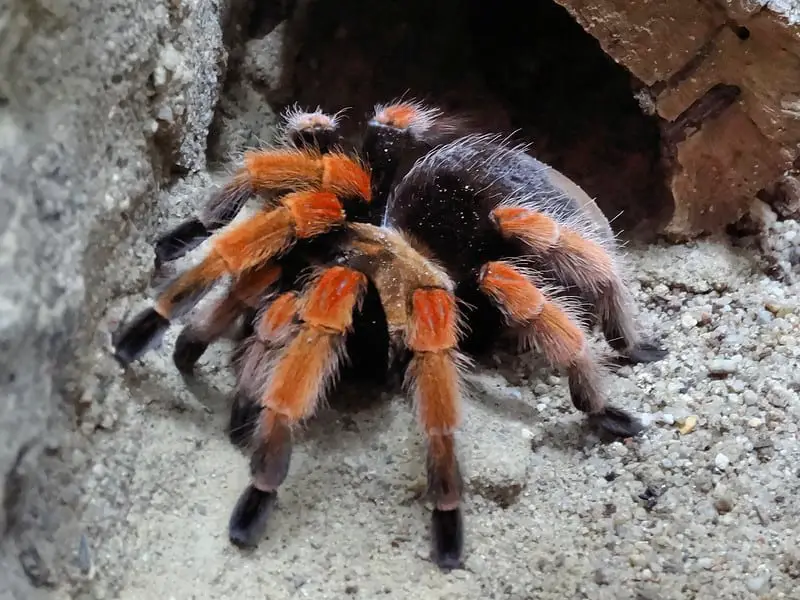
Mexican Fireleg Tarantulas are happy eating crickets and roaches but will eat small geckos if given a chance. As spiderlings, you should feed them twice a week with either flightless fruit flies or small crickets (pre-killed).
Juveniles can have three to four medium crickets or a medium roach once every week.
Adults can spend more time without eating, so four to five crickets or a large cockroach every two or three weeks will be enough for them.
They won’t eat if they’ve had enough, and they will also stop eating pre-molt and right after, so make sure to check and remove any remains and uneaten food to prevent bacterial growth.
If the abdomen is getting smaller and slimmer, you should increase the frequency in adults. If, on the other hand, the abdomen keeps getting larger, you should reduce the frequency or even the portions.
Health & Lifespan
The Mexican Fireleg Tarantula has an extremely long lifespan. Males live up to 8 years while females can live for a staggering 25 years! This means that buying one of these animals is a long-term commitment. You need to be prepared to take care of them for many years.
In captivity, these spiders do not have much to fear. They’re very hardy spiders that do not fall ill often as long as they’re cared for properly. The biggest threat to them are mites and parasites, so keep an eye out for those by making sure that you feed your tarantula captive-bred prey insects rather than wild-caught insects.
Ventilation is also important to ensure that mold and bacteria do not grow.
Breeding the Mexican Fireleg Tarantula
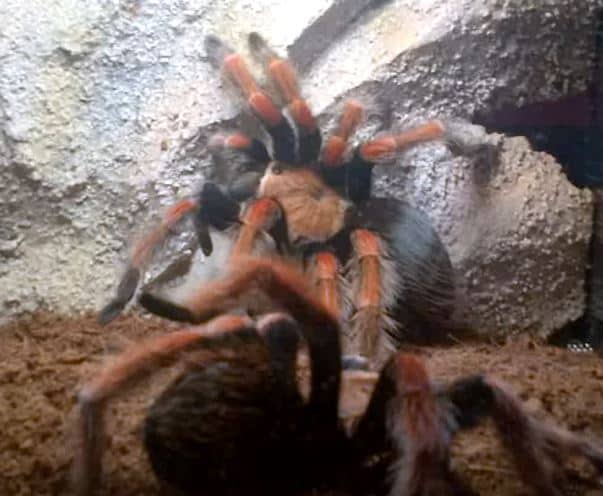
There are a few things to consider when you want to breed MFTs. However, before we dig into the specifics of breeding, I would like to issue a word of caution. Breeding is something that should not be done by novices or people who do not know what they’re doing. Tarantulas can lay hundreds of eggs which can result in many, many slings being born. These will then grow into large spiders which can be difficult to find homes for, breeding is something that’s best left to experts.
Before you start breeding, make sure both spiders are well fed and comfortable.
Secondly, you should attempt to breed about a month after the last time the female molted because if she molts between the mating and the laying, there’s a risk of losing the eggs.
Third, for about one month after the mating happens, you should decrease the temperature for the female specimen to around 65°F. After that month has happened, return the spider to her usual 75°F. This is done to simulate the winter season, something that some breeders have reported increases egg-laying.
About nine months after the mating, you should have a new egg sack. However, make sure you’re quick to retrieve the sack and put it in a safe place because these spiders are known for eating the eggs when some start to go bad.
Mexican Fireleg Tarantula Facts
- The Brachypelma boehmei was first described by Schmidt & Klaas in 1993.
- This species is endangered, if you do end up getting one, make sure that you buy from a reputable vendor that sells captive-bred specimens!
- The Mexican Fireleg has one of the slowest growth rates of all the South American tarantulas.
Final words
The Mexican Fireleg Tarantula isn’t the best spider for handling, so if you’re looking for a tarantula that you can carry around in your hand, you’re better off with other Brachypelma species such as the B. Hamorii.
However, if you’re interested in a beautiful spider for display, the Mexican Fireleg could be the right fit for you. Their defensive nature does not make them the ideal choice for first-timers, but hobbyists with a bit more experience can definitely consider adding this long-living species to their collection.
We hope that after this guide, you have all the information necessary to make that choice!
- How Long Do American Eskimo Dogs Live? Important Factors and Care Tips - September 29, 2023
- Do American Bulldogs Need Grooming? Essential Tips and Care Guidelines - September 29, 2023
- Do Bengal Cats Enjoy Playing? Essential Tips for Keeping Them Active - September 29, 2023